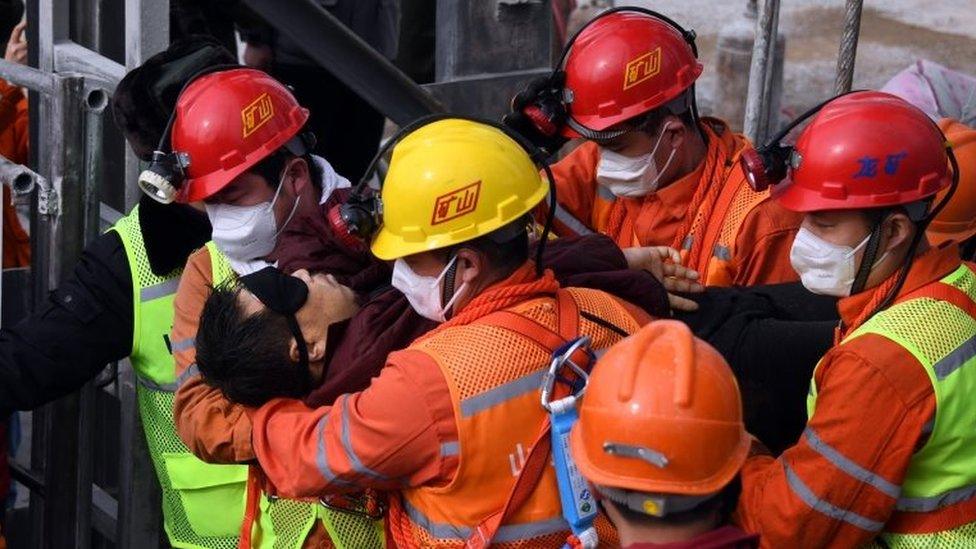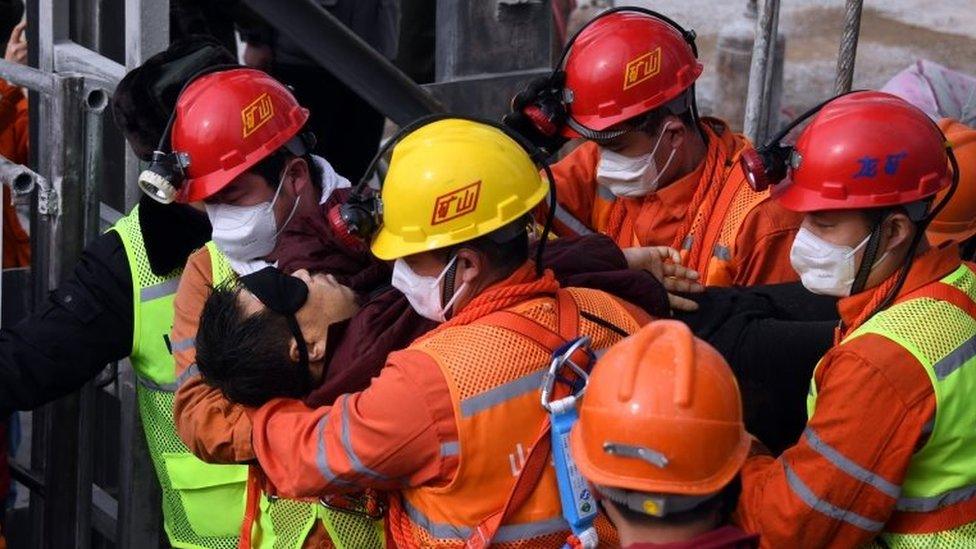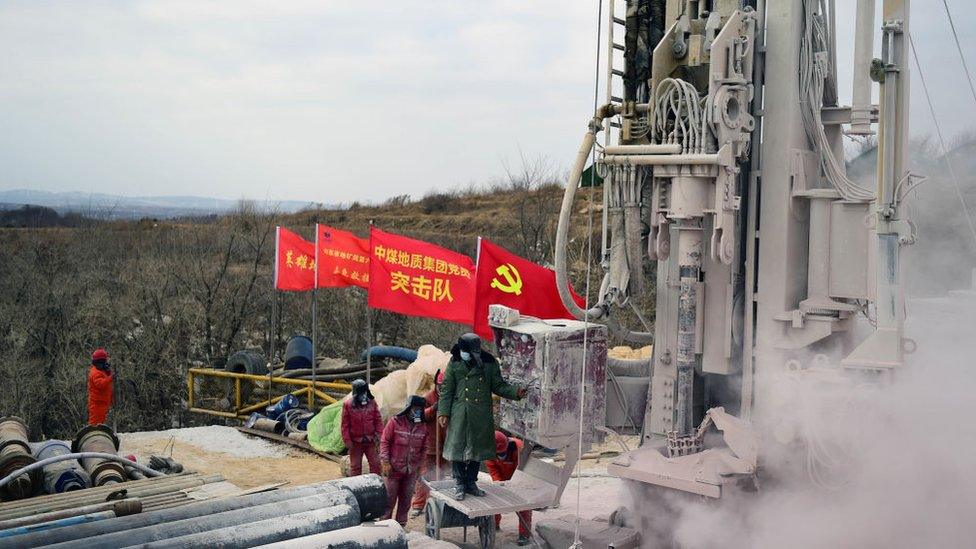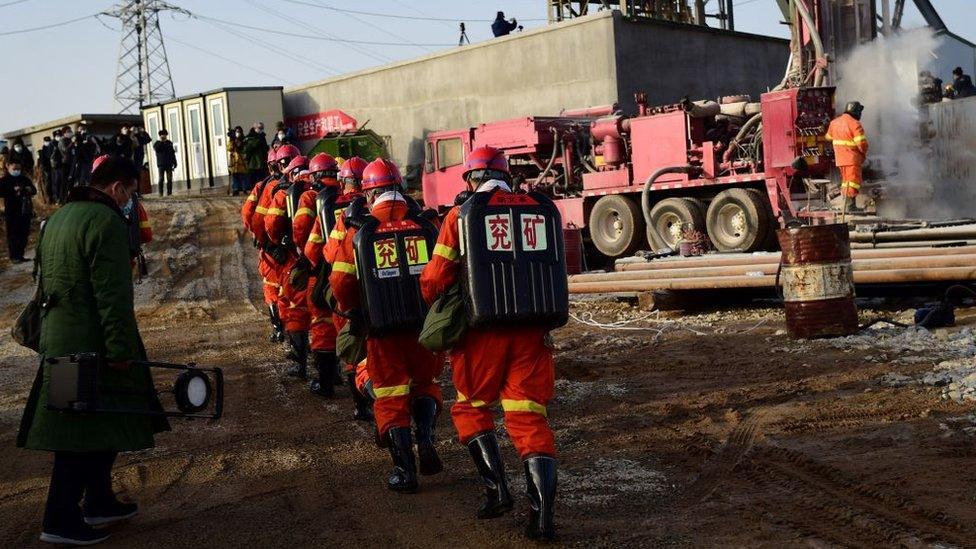China mine rescue: Miners saved after knocking on pipe
- Published
Chinese miners: 'I feel like I am reborn'
Two Chinese miners rescued after being trapped underground for two weeks have described how they made contact with rescuers - by knocking on a pipe.
They also spoke of their relief at being free, with one saying he "feels reborn", in their first comments since their dramatic rescue.
They were among 11 people pulled out alive after a 10 January blast in their gold mine in China's Shandong province.
Rescuers are still searching for one miner who remains unaccounted for.
Nine others have been found dead, while another died last week in the mine after falling into a coma.
TV footage from China showed the first miner being brought to the surface after two weeks underground
Speaking from his hospital bed on Tuesday, a miner identified as Du An told state media outlets: "When we heard the drills for the shaft nearing us, all of us stood up... we were too excited.
"There are no words to describe this feeling. I feel like I am reborn."
"We were trapped nearly 600m below ground, it was a daunting task," said another man, identified as Wang Kang. "We are so happy."
How did the men make contact with rescuers?
The miners also gave more details to the media about what happened to them after the blast.
The group of 22 men had been working on different parts of the mine, around 600m (2,000ft) beneath the surface, when the unexplained explosion happened, severely damaging entry to the mine and cutting off communication.
Recalling the first moments of the explosion, Mr Wang said that he could not see anything clearly when it happened. "It blasted us really far away, and our safety helmets cracked. After it was over, we quickly tried to look for other people."

State television showed Wang Kang recovering in hospital
For days, Mr Wang and Mr Du's group of 11 miners waited in vain to be rescued - they would only learn afterwards that company officials had reported the accident after a 30 hour delay. They had no food and sustained themselves only on water.
"There was plenty of water down there, but it's not very suitable for drinking. So we would only drink a little bit of it to survive," said Mr Du.
But he said they tried to keep up spirits throughout. "We comforted each other with encouraging words. That's how we pulled through."
Initial reports had said rescuers first realised there were survivors when they felt a pull on a rope lowered into the mine. But state media on Tuesday said the first sign of life was actually the sound of knocking on a pipe.
The miners told reporters that every day one member of the group would knock on a drill pipe that led to the surface.
Finally on 17 January, as Mr Wang knocked on the pipe five times - to indicate that they were in the fifth section of the mine - they were finally heard by rescuers, who knocked back in response.
"I heard over 20 knocks, but I didn't understand," said Mr Wang.
"I went back to discuss it with the other miners. We thought that could mean the number of miners underground, so I returned [to the pipe] and responded with 22 knocks."
How did the miners survive?
Rescuers eventually drilled a long, thin communication shaft down which they sent food, medicine, paper and pencils.
A paper note was then sent up on a rope from the group of 11 miners and a 12th trapped further below. A telephone line was also later established.
After that, contact with the 12th miner was lost, while one of the group of 11, who had fallen into a coma after sustaining a head wound in the explosion, was confirmed dead.


The miners received porridge and nutritional liquids, and a few days before their rescue, requested a traditional meal of sausages.
How did rescuers get the miners out?
Rescue efforts had been expected to take weeks, but took a "big step forwards" on Sunday morning when "a huge obstacle blocking the well suddenly fell to the bottom of the shaft," lead rescue worker Du Bingjian told the state-run Global Times.

The surviving miners wore blindfolds to protect their eyes after spending two weeks in darkness
As rescuers attempted to reach the main group of miners, they found another man who was still alive and was trapped in a different part of the gold mine.
TV footage showed him being lifted out as emergency workers cheered. He was blindfolded to protect his eyes from the light and was immediately taken to hospital for treatment, with his condition described as "extremely weak".
About an hour after that, rescuers reached the main group and pulled them out.
Several of them were seen walking by themselves, supported by rescue workers, before being transported to hospital.
The nine other miners who died were believed to have been in the "Sixth Central Section" of the mine, but details of how they were located are not yet known.
Officials are still searching for one last miner, while battling rising levels of groundwater flooding the mine.
Mining accidents are not uncommon in China, where the industry safety regulations can be poorly enforced. In December last year, 23 miners died after a carbon monoxide leak at a coal mine.
In September, 16 workers were killed at another mine on the outskirts of Chongqing, also due to carbon monoxide. In December 2019, an explosion at a coal mine in Guizhou province, south-west China, killed at least 14 people.
- Published24 January 2021

- Published22 January 2021

- Published20 January 2021

- Published18 January 2021
